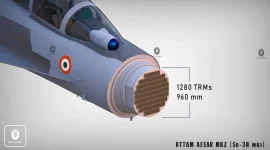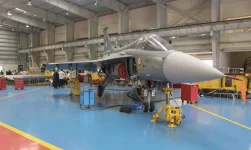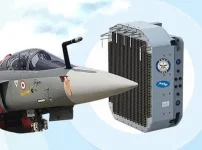- Views: 4K
- Replies: 11

India's domestically developed UTTAM radar has demonstrated a significant capability by successfully tracking a Tejas Mk-1 Light Combat Aircraft (LCA) at a range of 140 kilometers.
The test, conducted at Aero India 2025, showcases the radar's potential to significantly enhance the Indian Air Force's (IAF) air combat capabilities. The UTTAM radar was developed by the Defence Research and Development Organisation (DRDO).
The successful tracking of the Tejas Mk-1, a relatively small aircraft with a Radar Cross Section (RCS) of just over 1 square meter, is a noteworthy achievement. RCS is a measure of how detectable an object is by radar; a smaller RCS makes an aircraft harder to detect. The demonstration indicates the UTTAM radar's ability to identify targets that are typically challenging for many radar systems.
The UTTAM radar's performance is even more significant when considering its potential against aircraft like the Pakistani F-16 and JF-17. Both of these aircraft have a larger RCS than the Tejas Mk-1, making them theoretically easier to detect.
The F-16, a widely used fourth-generation multirole fighter in the Pakistan Air Force, has an estimated RCS ranging from 1.0 to 1.5 square meters, similar to LCA Mk1 but is much bigger. Because of its larger size and shape, the F-16 is expected to be detectable by the UTTAM radar at greater distances than the Tejas Mk-1.
Based on the 140km tracking range achieved against the Tejas Mk-1, experts estimate that the UTTAM radar could potentially detect an F-16 at ranges between 180 and 200 kilometers. This estimation factors in variables such as flight altitude, weather, and the relative positions of the aircraft. The radar's capacity to engage targets with a slightly larger RCS than the LCA Mk-1 puts it in a strong position in real combat situations.
The JF-17, a multirole combat aircraft jointly developed by Pakistan and China, also has modest stealth features, with an estimated RCS of around 1.5 square meters or slightly above. While larger than the Tejas Mk-1, it is still a relatively small target in terms of radar detection.
Considering the UTTAM's capabilities, it is projected that the radar could track the JF-17 at ranges similar to, or perhaps slightly greater than, those of the F-16. This would likely fall within the 160 to 180-kilometer range, given the radar's ability to detect targets with a more prominent RCS.
The UTTAM radar, equipped with approximately 900 Transmitter-Receiver (TR) modules, provides advanced tracking capabilities. The integration of the UTTAM radar onto platforms like the Tejas Mk-1A is expected to dramatically improve the aircraft's situational awareness, the accuracy with which it can target adversaries, and its overall survivability in contested airspace.
This advanced radar technology is poised to provide the IAF with a considerable advantage in air combat scenarios, allowing for earlier detection of potential threats and a more effective response.



